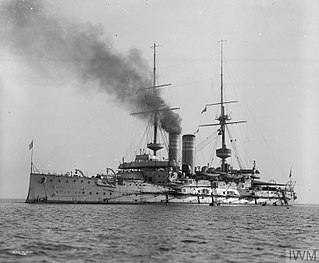
The British Mediterranean Fleet, also known as the Mediterranean Station, was a formation of the Royal Navy. The Fleet was one of the most prestigious commands in the navy for the majority of its history, defending the vital sea link between the United Kingdom and the majority of the British Empire in the Eastern Hemisphere. The first Commander-in-Chief for the Mediterranean Fleet was the appointment of General at Sea Robert Blake in September 1654. The Fleet was in existence until 1967.

The Atlantic Fleet was a naval fleet of the Royal Navy. It existed for two separate periods; 1909 until 1914, and then 1919 until 1932.

The Channel Fleet and originally known as the Channel Squadron was the Royal Navy formation of warships that defended the waters of the English Channel from 1854 to 1909 and 1914 to 1915.

The Battle Cruiser Fleet, (BCF), later known as Battle Cruiser Force, a naval formation of fast battlecruisers of the Royal Navy, operated from 1915 to 1919.

The Admiralty War Staff was the former senior naval staff operational planning organisation within the British Admiralty that existed from 1912 to 1917. It was instituted on 8 January 1912 by Winston Churchill in his capacity as First Lord of the Admiralty and was in effect a war council whose head reported directly to the First Sea Lord. After the First World War ended, the War Staff was replaced by the Admiralty Naval Staff department.

The Mobilisation Division was the former Directorate of the British Admiralty Naval Staff responsible for mobilisation requirements, manning and war preparation planning from 1912-1918.

The Admiralty Navy War Council was a temporary war planning and naval strategy advising committee of the Admiralty established in October, 1909 under Admiral Fisher it existed until 1911 when it was later replaced by the Admiralty War Staff.

The Department of the Director of Dockyards, also known as the Dockyard Branch and later as the Dockyards and Fleet Maintenance Department, was the British Admiralty department responsible from 1872 to 1964 for civil administration of dockyards, the building of ships, the maintenance and repair of ships at dockyards and factories, and the supervision of all civil dockyard personnel.

The 8th Battle Squadron was a squadron of the British Royal Navy assembled prior to the beginning of World War I; it was later assigned to the Third Fleet. The squadron consisted of pre-dreadnought type battleships. It existed from 1912 to 1914.

The Admiral Commanding, Reserves, (ACOMRES) was a senior Royal Navy post that existed from 1875 to 1976.

The 10th Cruiser Squadron, also known as Cruiser Force B was a formation of cruisers of the British Royal Navy from 1913 to 1917 and then again from 1940 to 1946.
The Flag Officer-in-Charge, Humber was the naval commander who administered the Humber Station also called the Humber Area a military formation of the Royal Navy located at Immingham and Grimsby, Lincolnshire, England. In World War I it was a sub-command of the Admiral of Patrols from 1914 to 1916, then came under the Commander-in-Chief at the Nore until 1921. In World War II the FOIC was responsible to the Commander-in-Chief, The Nore.
The British 13th Destroyer Flotilla , also known as the Thirteenth Destroyer Flotilla, was a naval formation of the Royal Navy from November 1915 – November 1918 and again from September 1939 to January 1944.
The14th Destroyer Flotilla also known as the Fourteenth Destroyer Flotilla was a naval formation of the British Royal Navy from April 1916 to 11 February 1919 and again from 1 June 1940 to January 1944.

The Eastern Mediterranean Squadron and later known as the British Aegean Squadron was a sub- command of the Mediterranean Fleet based at Mudros from 1914 to 1916 then alternating between Mudros and Salonika from 1917 to 1919.

The Red Sea Station was a military formation of the Royal Navy. At various times it has also been referred to as Egypt Division and Red Sea and later the Red Sea and Canal Area. The Royal Navy had distinct formations for the Red Sea at intervals from 1846 until 1959. In that year it was unified with the Senior Naval Officer, Persian Gulf under the new appointment of Commodore, Arabian Seas and Persian Gulf.
In the Royal Navy, a Divisional Transport Officer (DTO) or a Divisional Naval Transport Officer (DNTO) and later called a Divisional Sea Transport Officer (DSTO) is a shore-based naval officer responsible for the efficient working of the transports and boats of the flotilla, division or squadron under his charge.

The Black Sea and Caspian Squadron, also known as the Black Sea and Marmora Force and the Black Sea and Marmora Division, was a naval formation of the British Mediterranean Fleet from 1918 to 1919.

The White Sea Station was a naval station of the British Royal Navy headquartered at Archangel, Russian Empire from 1917 to 1919. The station was commanded by the Rear-Admiral Commanding in the White Sea later the Senior Naval Officer, White Sea.

The Sea Transport Branch of the British Board of Trade, originally established as the Transport Department or Naval Transport Department, was a logistical branch of the Department of Admiralty responsible for the provision of naval transportation services. It underwent numerous name changes throughout its complicated history with responsibility for sea transportation, known as the Department of the Director of Transports from 1890.







